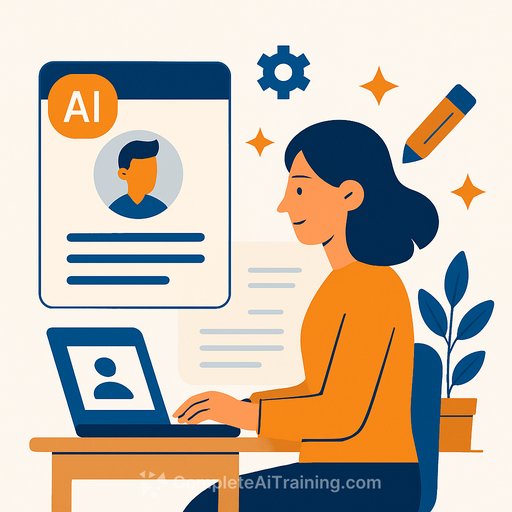AI wrote your job description. That's why it reads like every other one.
AI can draft a job post in seconds. Recruiters say it often makes hiring worse.
The problem isn't speed. It's signal. Generic output skips the hard thinking about outcomes, team context, and why a great candidate should care.
What recruiters are seeing
Paul DeBettignies, founder of Launch Hiring and Minnesota Headhunter LLC, cautions that automating job descriptions pushes hiring even further into a transactional rut. He notes that AI is trained on years of bland, recycled postings-so it tends to reproduce the same low-quality patterns.
Katrina Collier, recruiting author and facilitator, points to the root cause: weak intake. Many "accidental" managers haven't been trained to define roles, outcomes, or replacements. Instead of wrestling with the role, they paste an AI draft and move on-leaving candidates with a vague, forgettable post.
Why AI job posts flop
- Too many bullets, not enough outcomes.
- No clear reason to choose your company or team.
- Missing salary, benefits, and basics candidates care about.
Ask an AI model, "Why might someone not apply?" You'll hear those same three issues over and over.
Use AI as spackle, not a builder
Steve Visconti, CEO of Xiid, uses AI to fill gaps-not to write the post. He drafts first, then lets AI suggest missing skills (e.g., cloud native, Kubernetes, OpenShift), merges the best ideas, and keeps the human voice.
That workflow works if you already know who you need. If you don't, AI will amplify vagueness.
A practical workflow for HR
- Run a 30-minute intake with the hiring manager. Clarify the business problem, top 3 outcomes for 6-12 months, team context, and decision criteria.
- Define must-haves vs. nice-to-haves. Aim for 5-7 must-haves max.
- Write the first draft yourself. Lead with impact, outcomes, and why your team is worth their time.
- Add pay range, benefits, location policy, and interview process. Don't bury the lede.
- Now use AI to spot gaps: missing tools, unclear outcomes, redundant bullets, jargon.
- Ask AI to rewrite for clarity and inclusive language, in your voice. Keep or cut-your call.
- Legal and equity check. Confirm pay transparency requirements and inclusive phrasing.
Prompts that actually help
- "Act as a qualified candidate. What would stop you from applying to this role? Be blunt."
- "Rewrite this job description to focus on 3 measurable outcomes for the first 12 months."
- "Identify redundant or inflated requirements. Suggest the smallest set of must-haves."
- "List missing skills or tools commonly required for this role in [your industry]."
- "Rephrase to remove jargon and improve inclusivity. Keep it under 700 words."
Quality bar: what "good" looks like
- Clarity: 1-2 paragraphs on the business problem and outcomes.
- Specifics: tech stack, stakeholders, scope, constraints.
- Motivation: why this team, manager, and mission matter.
- Fairness: pay range, benefits, location policy, visa support.
- Focus: fewer bullets, more impact. Edit until it scans in under 90 seconds.
Manager intake made simple
- What business metric will this role move in 6-12 months?
- What will the hire ship or own by month 3, 6, and 12?
- What skills are non-negotiable vs. teachable?
- What has failed in this role before? Why?
- What would make a top candidate say "yes" in the first 10 lines?
Lightweight template you can copy
Why this role exists: The problem, the customers, and the measurable outcomes.
What you'll do: 5-7 bullets tied to outcomes and scope (avoid task soup).
What makes you a fit: 5-7 must-haves. Keep nice-to-haves to 3 or less.
Team and tools: Stack, stakeholders, collaboration patterns.
Pay and benefits: Range, equity (if any), key benefits, location, visa, interview steps.
Why us: The hook-mission, growth, manager's leadership style, learning budget.
Checklist before you publish
- Leads with outcomes, not a laundry list.
- Explains why someone would choose this team over a competitor.
- Includes pay range and core benefits.
- States location, onsite/remote policy, and time zones.
- Uses plain, inclusive language. Avoids vague clichés ("self-starter," "rockstar").
- Under 700-900 words. Mobile-friendly formatting.
Measure and improve
- Track apply-to-screened ratio and qualified applicants per week.
- A/B test the opening paragraph and pay transparency placement.
- Collect candidate feedback in the phone screen: "What stood out? What was unclear?"
Helpful resources
Want your team to use AI responsibly?
If you're upskilling recruiters and managers on prompt quality and review workflows, see these practical resources: Prompt engineering guides and AI courses by job function.
Your membership also unlocks:






